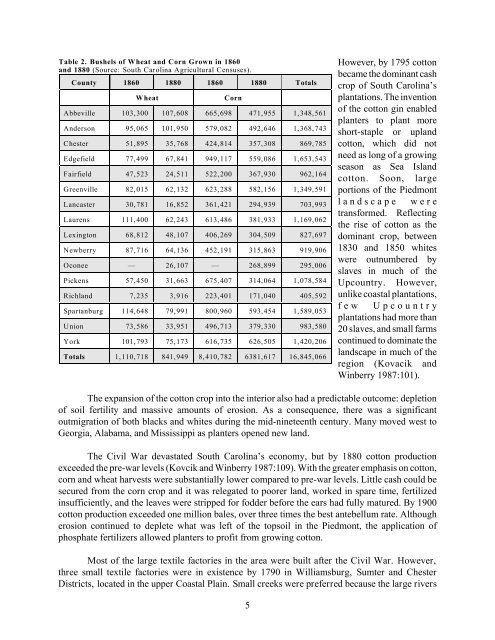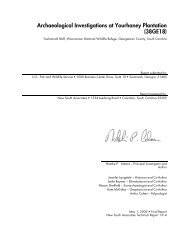Mills in the Upcountry: a Historic Context, and a Summary of a Mill ...
Mills in the Upcountry: a Historic Context, and a Summary of a Mill ...
Mills in the Upcountry: a Historic Context, and a Summary of a Mill ...
Create successful ePaper yourself
Turn your PDF publications into a flip-book with our unique Google optimized e-Paper software.
Table 2. Bushels <strong>of</strong> Wheat <strong>and</strong> Corn Grown <strong>in</strong> 1860<br />
<strong>and</strong> 1880 (Source: South Carol<strong>in</strong>a Agricultural Censuses).<br />
County 1860 1880 1860 1880 Totals<br />
Wheat Corn<br />
Abbeville 103,300 107,608 665,698 471,955 1,348,561<br />
Anderson 95,065 101,950 579,082 492,646 1,368,743<br />
Chester 51,895 35,768 424,814 357,308 869,785<br />
Edgefield 77,499 67,841 949,117 559,086 1,653,543<br />
Fairfield 47,523 24,511 522,200 367,930 962,164<br />
Greenville 82,015 62,132 623,288 582,156 1,349,591<br />
Lancaster 30,781 16,852 361,421 294,939 703,993<br />
Laurens 111,400 62,243 613,486 381,933 1,169,062<br />
Lex<strong>in</strong>gton 68,812 48,107 406,269 304,509 827,697<br />
Newberry 87,716 64,136 452,191 315,863 919,906<br />
Oconee — 26,107 — 268,899 295,006<br />
Pickens 57,450 31,663 675,407 314,064 1,078,584<br />
Richl<strong>and</strong> 7,235 3,916 223,401 171,040 405,592<br />
Spartanburg 114,648 79,991 800,960 593,454 1,589,053<br />
Union 73,586 33,951 496,713 379,330 983,580<br />
York 101,793 75,173 616,735 626,505 1,420,206<br />
Totals 1,110,718 841,949 8,410,782 6381,617 16,845,066<br />
However, by 1795 cotton<br />
became <strong>the</strong> dom<strong>in</strong>ant cash<br />
crop <strong>of</strong> South Carol<strong>in</strong>a’s<br />
plantations. The <strong>in</strong>vention<br />
<strong>of</strong> <strong>the</strong> cotton g<strong>in</strong> enabled<br />
planters to plant more<br />
short-staple or upl<strong>and</strong><br />
cotton, which did not<br />
need as long <strong>of</strong> a grow<strong>in</strong>g<br />
season as Sea Isl<strong>and</strong><br />
cotton. Soon, large<br />
portions <strong>of</strong> <strong>the</strong> Piedmont<br />
l<strong>and</strong>scape were<br />
transformed. Reflect<strong>in</strong>g<br />
<strong>the</strong> rise <strong>of</strong> cotton as <strong>the</strong><br />
dom<strong>in</strong>ant crop, between<br />
1830 <strong>and</strong> 1850 whites<br />
were outnumbered by<br />
slaves <strong>in</strong> much <strong>of</strong> <strong>the</strong><br />
<strong>Upcountry</strong>. However,<br />
unlike coastal plantations,<br />
few <strong>Upcountry</strong><br />
plantations had more than<br />
20 slaves, <strong>and</strong> small farms<br />
cont<strong>in</strong>ued to dom<strong>in</strong>ate <strong>the</strong><br />
l<strong>and</strong>scape <strong>in</strong> much <strong>of</strong> <strong>the</strong><br />
region (Kovacik <strong>and</strong><br />
W<strong>in</strong>berry 1987:101).<br />
The expansion <strong>of</strong> <strong>the</strong> cotton crop <strong>in</strong>to <strong>the</strong> <strong>in</strong>terior also had a predictable outcome: depletion<br />
<strong>of</strong> soil fertility <strong>and</strong> massive amounts <strong>of</strong> erosion. As a consequence, <strong>the</strong>re was a significant<br />
outmigration <strong>of</strong> both blacks <strong>and</strong> whites dur<strong>in</strong>g <strong>the</strong> mid-n<strong>in</strong>eteenth century. Many moved west to<br />
Georgia, Alabama, <strong>and</strong> Mississippi as planters opened new l<strong>and</strong>.<br />
The Civil War devastated South Carol<strong>in</strong>a’s economy, but by 1880 cotton production<br />
exceeded <strong>the</strong> pre-war levels (Kovcik <strong>and</strong> W<strong>in</strong>berry 1987:109). With <strong>the</strong> greater emphasis on cotton,<br />
corn <strong>and</strong> wheat harvests were substantially lower compared to pre-war levels. Little cash could be<br />
secured from <strong>the</strong> corn crop <strong>and</strong> it was relegated to poorer l<strong>and</strong>, worked <strong>in</strong> spare time, fertilized<br />
<strong>in</strong>sufficiently, <strong>and</strong> <strong>the</strong> leaves were stripped for fodder before <strong>the</strong> ears had fully matured. By 1900<br />
cotton production exceeded one million bales, over three times <strong>the</strong> best antebellum rate. Although<br />
erosion cont<strong>in</strong>ued to deplete what was left <strong>of</strong> <strong>the</strong> topsoil <strong>in</strong> <strong>the</strong> Piedmont, <strong>the</strong> application <strong>of</strong><br />
phosphate fertilizers allowed planters to pr<strong>of</strong>it from grow<strong>in</strong>g cotton.<br />
Most <strong>of</strong> <strong>the</strong> large textile factories <strong>in</strong> <strong>the</strong> area were built after <strong>the</strong> Civil War. However,<br />
three small textile factories were <strong>in</strong> existence by 1790 <strong>in</strong> Williamsburg, Sumter <strong>and</strong> Chester<br />
Districts, located <strong>in</strong> <strong>the</strong> upper Coastal Pla<strong>in</strong>. Small creeks were preferred because <strong>the</strong> large rivers<br />
5







